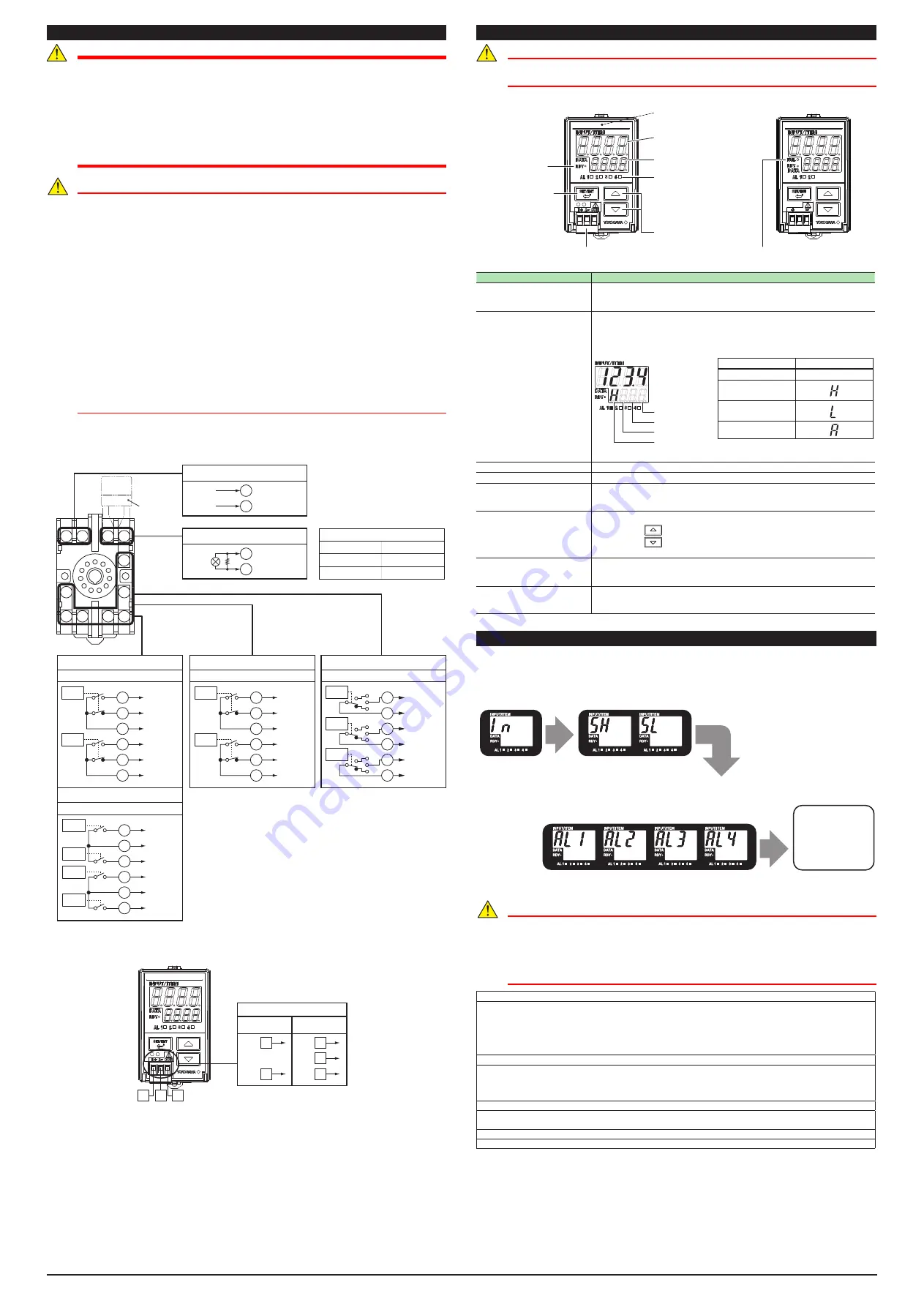
IM 77J04H31-01E 4th Edition
Oct. 15, 2019-00
2
4. EXTERNAL WIRING
WARNING
●
To avoid the risk of an electric shock, turn off the power supply and use a tester or
similar device to ensure that no power is supplied to a cable to be connected, before
carrying out wiring work.
●
Do not operate the product in the presence of flammable or explosive gases or
vapors. To do so is highly dangerous.
●
Use of the product ignoring the specifications may cause overheating or damage.
Before turning on the power, ensure the following:
•
Power supply voltage and input signal value applied to the product should meet the
required specifications.
•
The external wiring to the terminals and wiring to ground are as specifications.
CAUTION
●
The power line and input/output signal lines should be installed away from noise-
generating sources. Otherwise accuracy cannot be guaranteed.
●
The product is sensitive to static electricity; exercise care in operating it. Before you
operate the product, touch a nearby metal part to discharge static electricity.
●
If an inductance (L) load such as auxiliary relays or solenoid valves is used, always
insert a spark killer for diminishing sparks, such as a CR filter or a diode in parallel
with the inductance load. Otherwise a malfunction or relay failure may occur. Refer to
the following guidelines for a capacitor and resistor:
Capacitor: 0.5 to 1 µF with respect to a contact current of 1 A
Resistor: 0.5 to 1 Ω with respect to a contact voltage of 1 V
●
Transfer contacts for 2 points of alarms consist of an NO contact and an NC contact.
When using transfer contacts, consideration should be given to the risk of a short
circuit due to contact MBB
*1
resulting from non-concurrent action of the NO and NC
contacts or to a short circuit caused by arcs produced when opening a contact at
large current.
*1 The condition where both NO and NC contacts close when the contact actuates
●
Fail output of the fail output type is energized during normal operation and de-
energized on FAIL (same as when the power is turned off).
•
When NO is specified: The contact opens when it is FAIL.
•
When NC is specified: The contact closes when it is FAIL.
●
Do not connect anything to the terminals that are not used in the wiring diagram.
Wiring should be connected to the terminals on the socket of the MVHK. The terminals for external
connections are of M3.5 screws. Use crimp-on lugs for connections to the terminals.
It is recommended that signal wires have a nominal cross-sectional area of 0.5 mm
2
or thicker, while
the power cable has a nominal cross-sectional area of 1.25 mm
2
or thicker.
10 11
1 2
3
9
8 7
6 5
4
5
6
R
–
+
10
11
9
2
3
1
(IN)
10
9
11
2
1
3
7
8
N–
L+
(SUPPLY)
1
2
3
10
11
4
NO
NC
NO
NC
NO
NC
1
2
10
11
3
4
Resistance value
100
Ω
250
Ω
Part number
RES-100
RES-250
MVHK-00
[]
-
[]
1
[]
0
MVHK-00
[]
-
[]
2
[]
0
NO
NC
COM
NO
NC
COM
NO
COM
NO
NO
COM
NO
MVHK-10
[]
-
[]
1
[]
0
NO
NC
COM
COM
COM
COM
NO
NC
COM
Relay
Relay
Relay
Relay
Relay
Relay
Relay
Relay
MVHK-20
[]
-
[]
3
[]
0/F
[]
Alarm 1
(ALM1)
Alarm 1
(ALM1)
*
*
*
Alarm 2
(ALM2)
Alarm 2
(ALM2)
Alarm 1
(ALM1)
Alarm 1
(ALM1)
Alarm 4
(ALM4)
Alarm 2
(ALM2)
Alarm 3
(ALM3)
Alarm 2
(ALM2)
Fail output
(FAIL)
Relay
Relay
Relay
* The setting of NC or NO
depends on the optional
specifications at the time of
order. This setting can not be
changed after delivery.
Input signal
Power supply
Receiving
resistor
Receiving resistor
R: 100 Ω or 250 Ω, externally connected for current input
2 points of alarm outputs
Fail output type
4 points of alarm outputs
2 points of alarm outputs (JK12 type)
Wiring for Monitor Output
If the monitor output code (one of 6, A or P) is specified at the time of order, the following wiring is
possible.
A–
COM
B+
–
+
1
1
3
1
2
3
2 3
Monitor output
Analog output
RS-485
communication
5. PART NAMES OF FRONT PANEL AND THEIR FUNCTIONS
CAUTION
The front panel of the product is constructed to prevent opening. Forcing it open will
result in breakage.
Fail output type
(1) PV (measured value)
display
Place for adhering
the tag number label
(2) DATA display
(3) Alarm indicator lamp
2 points of alarms:
2 lamps
4 points of alarms:
4 lamps
(7) Monitor output terminal (option)
(8) Fail indicator lamp
(6) UP/DOWN key
(5) SET/ENT
key
(4) READY
lamp
Part Name
Function
(1) PV (measured value)
display
Displays a measured value during operation.
Displays a parameter symbol when a parameter is set.
Displays an error code in the event of an error.
(2)
DATA display
Displays the setpoint of a variety of parameters.
Displays an alarm type in the event of an alarm. (Not displayed during
normal operation.)
• Alarm display (when alarm 1 is the PV high-limit alarm)
Alarm-1
Alarm-2
Alarm-3 *
Alarm-4 *
Display position
of alarm action
type
Alarm action
Alarm action type
No alarm (normal)
None
PV high limit
alarm
PV low limit
alarm
Other alarms
*Alarm-3 and Alarm-4 are 4 points alarm only.
(3)
Alarm indicator lamp
In the event of an alarm, AL1 to AL4 (alarm 1 to alarm 4) light up.
(4)
READY lamp
Lights up when the power is turned on.
(5) SET/ENT key
Used to switch parameter indication or accept a setpoint.
Pressing this key for more than 3 seconds allows you to select the
Operation Parameter Screen and Setup Parameter Screen alternately.
(6) UP/DOWN key
Used to change the setpoint of a parameter.
Pressing the
key increases a numerical value.
Pressing the
key decreases a numerical value.
Holding down a key accelerates the speed of change.
(7)
Monitor output terminal
(Two-piece connector)
Outputs 1 to 5 V DC, 4 to 20 mA DC or RS-485 communication signal.
(To be added only when the monitor output has been specified at the
time of order.)
(8)
Fail indicator lamp
Lights up in a fault condition. The self-diagnosis function detects the Fail status *.
* EEP sum error, EEP error, AD error, ROM error, RAM error
(When type code 2 is specified when ordering.)
6. PARAMETER SETTING ORDER AND PRECAUTIONS
When setting a parameter, begin with Step 1 below and continue in sequence.
Range code No.
(IN)
Max./min. input scaling values
(SH) (SL)
You can enter either parameter first.
You can begin with any of these parameters.
Alarm-1 action
Alarm-2 action
Alarm-3 action
Alarm-4 action
(AL1) (AL2) (AL3) (AL4)
After that, you may
proceed with
settings beginning
at any parameter.
Step 2
Step 3
Step 1
CAUTION
●
If the settings for the range code No. (IN), maximum and minimum input scaling
values (SH)/(SL) or alarm actions (AL1 to AL4) are changed, the relevant parameter
setpoints shown in the table below will be initialized. To change a parameter setpoint,
begin with Step 1 above and continue in sequence.
●
Do not turn off the power of this product while changing the parameters of this
product or adjusting this product.
Parameters to be initialized if the range code No. (IN) is changed
Max. and min. measured input values (RH, RL), decimal point position of scaling value (SDP), max. and min. input
scaling values (SH, SL)
Alarm setpoints (A1 to A4), hysteresis (HY1 to HY4), setpoint (SP)
Max. and min. monitor output values (RTH, RTL)
Input adjustment point LOW (BL) and HIGH (BH), input adjustment LOW (AL) and HIGH (AH)
High and low limits for PV display color change (PCH, PCL)
Parameters to be initialized if the maximum or minimum input scaling value (SH) or (SL) is changed
Alarm setpoints (A1 to A4), hysteresis (HY1 to HY4), setpoint (SP)
Max. and min. monitor output values (RTH, RTL)
Input adjustment point LOW (BL) and HIGH (BH), input adjustment LOW (AL) and HIGH (AH)
High and low limits for PV display color change (PCH, PCL)
Parameters to be initialized if the type of alarm action (AL1 to AL4) is changed
The alarm setpoint (A1 to A4) corresponding to each alarm action (AL1 to AL4)
(Example: If AL1 is changed, A1 will be initialized.)
Parameters to be initialized if the type of PV display color mode (PCM) is changed
High and low limits for PV display color change (PCH, PCL)


























